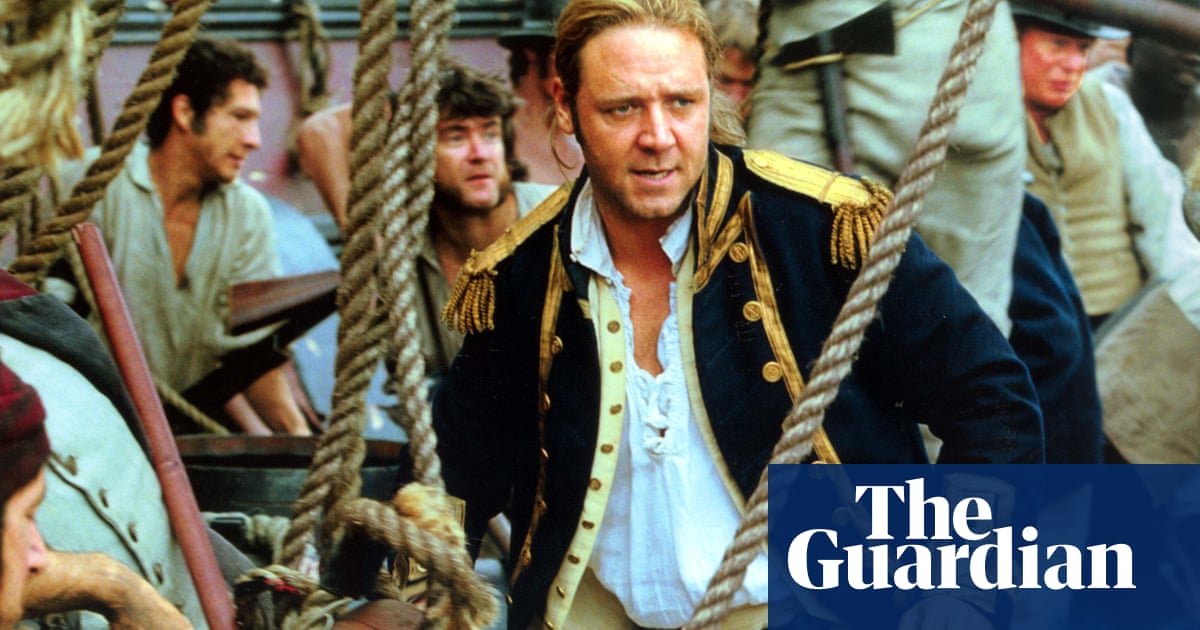
“Straight at ’em, Mr Mowett.”
So says Russell Crowe, as Captain “Lucky Jack” Aubrey, in Master and Commander: The Far Side of the World, as battle with a French ship looms.
“Straight at ’em, sir,” replies Edward Woodall, playing 2nd Lt William Mowett.
Twenty years on, Peter Weir’s film remains a masterpiece, a miracle of forceful, direct, intelligent action cinema. To paraphrase Ulysses S Grant on the art of (land) war, as an action movie, Master and Commander is simple enough. It finds out where its viewer is, gets at them as soon as it can, strikes them as hard as it can, and keeps moving on.
Grant was laconic but Lucky Jack boils him down. Master and Commander is a film that goes straight at ’em.
And yet it is so much more. It is based on parts of a number of novels, the Aubrey-Maturin series. Patrick O’Brian wrote them and at his death in 2000, there were 20 and one unfinished. The series follows Aubrey and his friend, Stephen Maturin, a physician, naturalist and spy, through the Napoleonic wars and up the ranks of the Royal Navy.
O’Brian wrote a whole intricate world, a comprehensive picture of 18th- and early 19th-century naval warfare, laced with intrigue and adventure. Weir filmed that world, above and belowdecks on a (replica) British frigate, the Surprise, playing cat and mouse with a French ship, Acheron, either side of Cape Horn.
Weir’s actors peopled that world. Crowe inhabited Lucky Jack, bluff and belligerent, an old-school Tory but a man of parts too. Paul Bettany captured Maturin’s duality, a man of science and enlightenment by turns enchanted, exasperated and appalled by his friend. After the battle, they play violin and cello together, playing their ship into the sunset. The supporting cast was perfectly picked: James D’Arcy as 1st Lt Tom Pullings, Aubrey’s dashingly scarred protege, given his first command. Robert Pugh as Mr Allen, Master, a skeptic at the captain’s table. Billy Boyd as Barrett Bonden, coxswain. Max Pirkis as Lord Blakeney, midshipman, doomed to lose an arm.
Famously, there is just one female face in Master and Commander: a beautiful one, seen off the coast of the Americas, from the ship’s railing and by Lucky Jack, his gaze lingering long enough to establish his, shall we say, leading man credentials. There is rum and the lash in Weir’s film. The other thing, less so.
Some may say Master and Commander is just too male, and too white, to be called a true classic. I may say, if so, that some should have a word with my mum, a teacher of English literature, a lover of Eliot and Austen who treats O’Brian’s novels as holy writ and loves the film as much as me. Arising from which, a confession: I haven’t read O’Brian’s books. I got about a chapter into the first novel, Master and Commander itself, before deciding I’d rather read Flashman. In my defense, I was 16 and an idiot.
But I love the movie.
There is cricket in it, while the crew of the Surprise rest and refit, a sight to gladden any British eye lost in Hollywood film. That scene is set on the Galápagos, where Maturin is able to briefly indulge his passion: he turns out a proto-Darwin, lovingly yet knowingly shown crating up birds and iguanas. Then the Acheron heaves back into view, introduced like the shark in Jaws, and the game is afoot once more. Lucky Jack hatches a plan to lure her in, pretending to be a defenceless whaler, appealing to Maturin and Blakeney’s study of camouflage in nature. The French ship takes the bait.
At Crowe’s signal – just three years after he began his other major historic epic role, Gladiator, with a battle in a German forest at dawn – his men unleash hell. The final battle is a blast of smoke and oakum: kinetic, thrilling, terrifying. As visceral as the floors of the ship as cannonballs and sabres do their work. “More sand here!” Maturin cries, wielding blades and saws. Elsewhere, he even operates on himself, digging out a bullet. Also, using a coin, he performs a graphic trepanning.
Master and Commander is an action movie with a brain. Its thrills are never mindless. Weir’s recreation of life in the close confines of a warship in 1805 is meticulous, fascinating and sometimes, rightly, nausea-inducing. Crowe and Bettany’s interpretation of a friendship between two men matches such artistry precisely. As Gabriella Paiella said for GQ earlier this year, much of the film’s lasting appeal springs from that portrayal of male closeness.
“March – 2023,” Paiella wrote, parodying the much-loved title card to the film, which segues into shifting views of a warship under sail in the night.
“Napoleon is master of Europe. Only the British fleet stands before him. Oceans are now battlefields. And a moderate box office success from 2003 has become an unlikely streaming favorite, a poster child for the kind of movies Hollywood doesn’t make anymore, and a beacon of positive masculinity.”
Take it from me, a middle-aged man whose closest male friends all live across 3,000 miles of ocean (and who, yes, owns a T-shirt with that title card on it), Master and Commander really does present an inspiring view of relationships vital to health and happiness.
So why was this marvel of modern cinema only a modest box office success? And why have there been no sequels, in an age of universes and franchises based on source material of infinitely less literary weight than O’Brian’s, never mind a whole Ridley Scott movie devoted to “that raggedy arse Napoleon”? (Which I can’t wait to see.)
Master and Commander was well reviewed and widely nominated: 10 times for Oscars, including best picture and best director. It won two, on the technical side. More importantly, it was expensive – shot on a replica, partly on the high seas, for $150m – so it wasn’t hugely profitable, earning about $210m worldwide.
In 2005, as the age of the superhero franchise swung firmly into gear, Weir told the Seattle Times a second voyage with Lucky Jack was “most unlikely” because his film “did well-ish at the box office [but] didn’t generate that monstrous, rapid income that provokes a sequel”.
And so though Russell Crowe wanted to play Lucky Jack again, he didn’t. And most likely won’t, even if it’s not impossible to imagine him as R Adm Aubrey in Blue at the Mizzen, the last O’Brian novel, set after Napoleon’s defeat.
But, appropriate to the film’s rapid meme-ification – the lesser of two weevils for grumpy old guys like me, if it means new generations come to the film – something that spread rapidly on the internet offers some sort of hope.
Reports of a new movie, a prequel, have been around forever. Last year, an image spread of a supposed unveiling of an “Aubrey-Maturin Saga”, complete with release dates, from Master and Commander: Post Captain (spring 2023) to Master and Commander: The Reverse of the Medal (spring 2027).
To quote Garth Franklin, editor of DarkHorizons.com: “Needless to say this is not real, but God I wish it were.”
Martin Pengelly’s book, Brotherhood: When West Point Rugby Went to War, is published in the US by Godine












